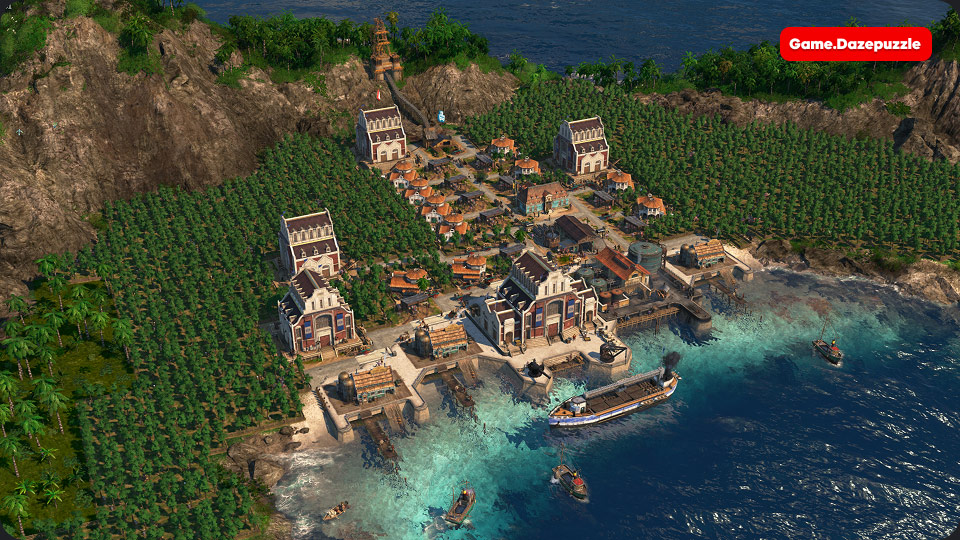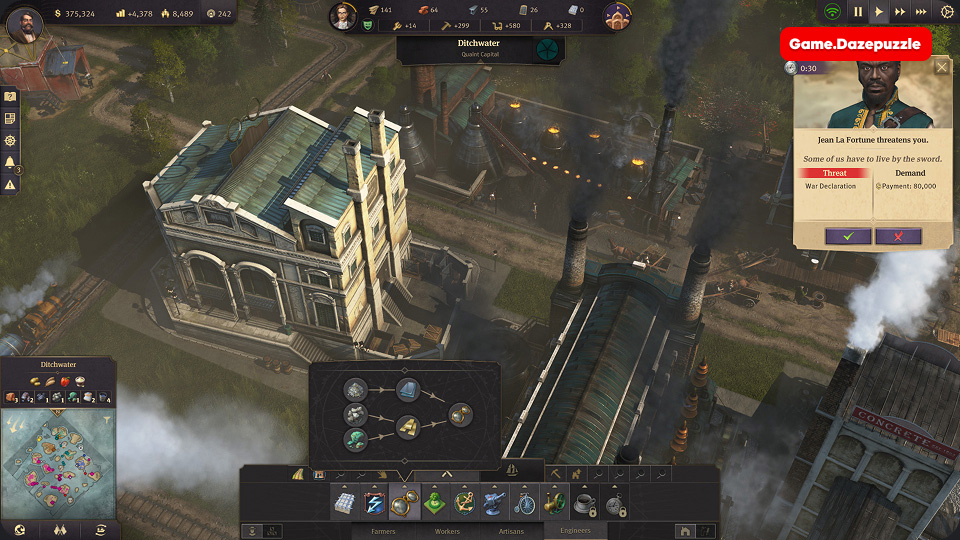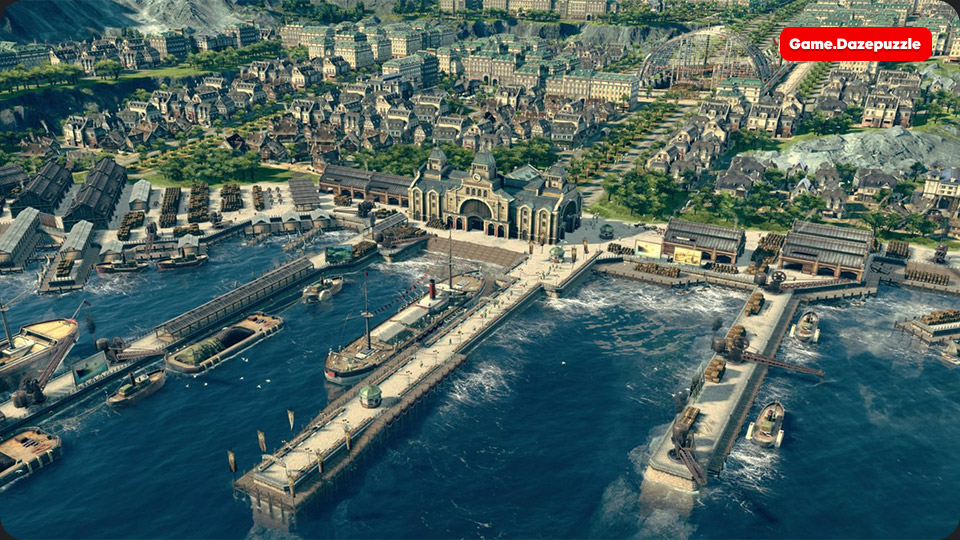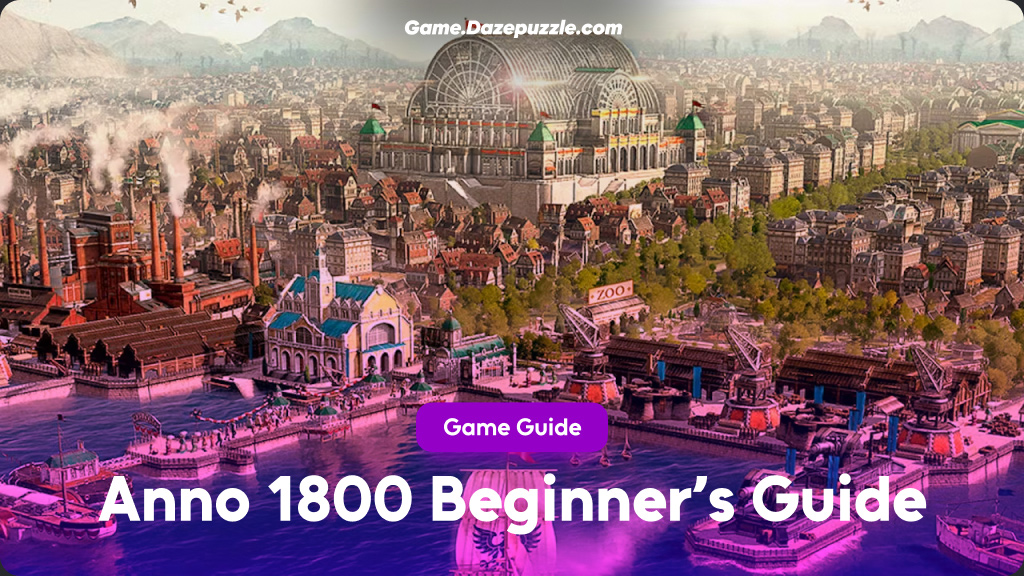Imagine stepping onto the bustling docks of a 19th-century harbor, the salty breeze carrying the hum of ambition. Smoke curls from factory chimneys, ships glide across the horizon, and your fledgling settlement teeters on the edge of greatness. Welcome to Anno 1800, a city-building masterpiece where you’ll transform a humble village into a sprawling industrial empire. Whether you’re new to the Anno series or just dipping your toes into this vibrant world, this Anno 1800 beginner’s guide is your roadmap to thriving in the age of industry. Let’s dive in and start building!
What You will read in this Article
Getting Started: Your First Island
When you launch a sandbox game in Anno 1800, you’re dropped onto a starting island with a harbor, a flagship, and enough resources to kick things off. Your goal? Grow a thriving population, produce complex goods, and outsmart rival companies vying for dominance. The game offers preset difficulties, normal or advanced are great for beginners, or you can tweak settings to remove AI opponents for a chill city-building vibe.

Your first task is to claim your island and plan its layout. Every island has unique resources and fertilities, like potatoes or wheat, which determine what you can produce. Your starting island always has potato fertility, perfect for feeding your early farmers with schnapps. But to grow beyond the basics, you’ll need to scout other islands for resources like hops, clay, or iron. Settling a new island is as simple as sailing your ship to its coast and clicking to colonize. Once claimed, it’s yours, no one else can build there.
Pro tip: When choosing a second island, pick one with resources your starting island lacks. This ensures you’re expanding efficiently, setting the stage for a robust economy.
Building Your City: The Heart of Anno 1800
At its core, Anno 1800 is about keeping your citizens happy and productive. Your city starts with a handful of farmers, but as you meet their needs, they’ll upgrade to workers, artisans, and beyond. Each population tier unlocks new buildings, goods, and challenges.
The Marketplace: Your Village Hub
Your first building should be a marketplace. Think of it as the beating heart of your settlement, where citizens grab their groceries and gossip. Markets need a road connection to your harbor, and houses must be within 35 tiles to fully benefit. Place your market centrally, away from cliffs or coasts, to maximize its reach. Use blueprint mode (a lifesaver!) to test layouts without spending resources. Once you’re happy, upgrade the blueprint to a real building.
Surround your market with a few farmer residences. These houses will fill with people as long as their basic needs, access to the market, fish, and clothing, are met. Click a house to check its supply status; if it’s at 100%, your farmers are thriving. If not, they’re too far from the market, and growth will stall.
Understanding Population Needs
Every residence has two types of demands: needs and happiness. Needs, like food and clothing, drive population growth. Meet all needs, and a house will hit its population cap (e.g., 10 farmers). Happiness, tied to luxury goods like schnapps, boosts your tax income. To upgrade farmers to workers, you’ll need to fully satisfy their needs and max out their population. But beware, upgrading doubles the house’s population (to 20 workers), increasing demand for goods and straining your production.
Neglect your people for too long, and they might riot. Keep an eye on happiness to avoid unrest, which we’ll cover later.
Mastering Production Chains
Production is the backbone of your economy. Every good, from timber to beer, follows a production chain, a series of buildings that transform raw resources into finished products. Let’s break it down with a simple example: building houses.
Timber: Your First Production Chain
Houses require timber, which starts with wood from a lumberjack hut. Here’s how it works:
- Lumberjack Hut: Produces 1 wood every 15 seconds, requiring 5 farmers.
- Sawmill: Turns 1 wood into 1 timber every 15 seconds, needing 10 farmers.
This is a 1:1 ratio, so one lumberjack hut pairs perfectly with one sawmill. Place them close together to minimize cart travel time. Both buildings need a road connection to a warehouse, which stores your goods. Warehouses are like magical chests, resources stored in one are accessible across all warehouses on the island.

When planning production, consider three factors:
- Production Time: Ensure buildings match their input/output rates (like the 1:1 wood-to-timber example).
- Workforce: Check your available workforce at the top of the screen. A lumberjack hut and sawmill need 15 farmers total.
- Warehouse Load: Too many buildings dumping goods into one warehouse can cause backups. Keep warehouses close to production sites.
Use blueprint mode to map out chains before committing. If you overbuild, your workforce spreads thin, slowing everything down. For efficiency, place related buildings (like lumberjack huts and sawmills) next to each other to skip the warehouse trip.
Scaling Up: More Chains
As your population grows, you’ll need more complex goods. For farmers, set up these chains:
- Potatoes to Schnapps: Potato farms and schnapps distilleries have a 1:1 ratio.
- Wool to Clothing: Sheep farms and framework knitters are also 1:1.
- Fish: Fishery huts supply fish directly, no processing needed.
For workers, you’ll need bread (wheat farms to flour mills to bakeries), sausages (pig farms to slaughterhouses), and beer (hops farms to malthouses to breweries). Some chains, like bricks (clay pits to brick factories), have a 2:1 ratio, so one clay pit supports two brick factories. Always check production times and workforce needs to keep things balanced.
Managing Your Inventory
Your harbor or warehouses show your island’s inventory, with a key category: consumer goods. These are the items your population eats, wears, or drinks. A red arrow next to an item means you’re consuming it faster than you’re producing it, time to build more production buildings. Running out of basic needs shrinks your population, while missing luxury goods tanks happiness and income.
If you’re short on goods, you can buy from NPC traders or AI ports, but their visits are unpredictable. Alternatively, sell excess goods to NPCs for steady cash. Overproduction isn’t a bad thing if you’re trading surplus for profit. To avoid shortages, build extra warehouses for more storage, giving you a buffer to fix supply issues.
Expanding Your Empire: Trade and Exploration
One island won’t cut it for long. To grow, you’ll need to colonize new islands and set up trade routes to share resources.
Settling New Islands
When scouting islands, check their fertility and resources. If your starting island has potatoes but no wheat, claim an island with wheat fertility. Colonizing is easy, sail to the island, click to settle, and it’s yours. You don’t need to build immediately; just secure it to block rivals.
Trade Routes
Each island has its own inventory, so trade routes are essential for sharing goods. There are two types:
- Custom Trade Routes: You control the ship, stops, and cargo. Set rules like “wait until full” or “dump excess goods.” These are great for moving goods between your islands or trading with NPCs.
- Charter Routes: The AI handles these for a fee. They use smaller ships (80 tons vs. 100 for your schooners) and are less reliable, but they’re handy if you’re short on ships.

Trade routes can be attacked by pirates or hostile AI, so escort them with military ships or set patrol routes to keep enemies at bay.
The New World
Once you hit tier three (artisans), you can send expeditions to discover the New World, a tropical biome with unique population classes and resources like bananas. The gameplay mirrors the Old World, but you’ll need trade routes to shuttle goods between regions. Use Clipper ships (200-ton cargo holds) for long voyages, and run multiple ships in rotation to keep goods flowing.
You might also like this: Top 10 Competitive Multiplayer Games
Advanced Mechanics: Influence and Electricity
As your empire grows, you’ll unlock new systems to optimize your cities.
Influence
Influence is a resource tied to your population size. You don’t spend it, you invest it in buildings like trade unions or military ships. Investing enough in a category (e.g., optimization for trade unions) unlocks buffs, like lower maintenance costs. If you change your mind, dismantle the buildings to reclaim influence. Want more influence? Grow your population.
Electricity
At tier four (engineers), electricity supercharges your factories. Oil wells and refineries produce oil, which is transported via railways (not roads) to an oil harbor. Power plants then use oil to generate electricity, boosting nearby factories’ efficiency by 100%. Engineers also need electricity to grow beyond 1750, so place power plants near residences. Keep railway lines short and create closed loops to avoid train collisions.
Dealing with Disasters
Your city isn’t immune to chaos. Fires, riots, and diseases can derail your progress, but preparation minimizes their impact.
Fires
High building density increases fire risk. Build fire stations with road access to cover your city. If a fire breaks out, firefighters will rush to extinguish it. Mobilize extra crews for faster response, but if the fire rages too long, buildings turn to ruins, requiring costly rebuilds.

Riots
Unhappy citizens may riot, especially if luxury goods are scarce. Police stations calm riots, with officers going door-to-door. Boost happiness quickly by lowering work conditions in production buildings, though this reduces output.
Diseases
Sickness spreads fast, even to ships, infecting other islands. Hospitals with road access deploy doctors to contain outbreaks. Stop infected ships from sailing until the disease is under control. Happy cities can mobilize extra doctors for faster recovery.
Competing with Rivals: Shares and War
Anno 1800 isn’t just about building, it’s about outsmarting rivals. You can dominate through economics or military might.
Buying Shares
Every island has five shares. Buy a share in a rival’s island to earn a cut of their income. The price depends on the island’s population. Each purchase angers the AI, and they can buy shares in your islands, too. If you own all five shares, the island becomes yours, but it’s wiped clean. There’s a 10-minute cooldown between share purchases, so hostile takeovers take time. If cash is tight, sell shares back to the owner or the crown.
War
For a more direct approach, declare war and siege a rival’s harbor. Defeat their defenses, and the island’s morale drops, forcing surrender. You can claim all shares (keeping the island intact) or take it outright (wiping it clean). Naval combat rewards strategy, position ships for broadside attacks and pull damaged vessels to repair cranes. Set ship stances to defend trade routes or hunt pirates.
Boosting Efficiency: Items and Buildings
Quests from citizens, NPCs, and AI reward items that buff your empire. Place these in key buildings:
- Trade Unions: Buff production buildings within their radius, increasing efficiency or reducing costs.
- Town Halls: Boost happiness or income for nearby residences.
Items can also enhance ships for expeditions, which unlock at tier three. Prepare a ship with goods (e.g., soap for medicine) and navigate dilemmas to earn rewards. Success can yield powerful items or resources.
Tips for Success
To wrap up, here are some golden nuggets to keep your empire humming:
- Always use blueprint mode to plan layouts, it’s free and flexible.
- Balance production chains to avoid shortages or overproduction.
- Claim islands early to secure resources, even if you don’t build right away.
- Monitor consumer goods in your warehouses to spot supply issues.
- Escort trade routes to protect them from pirates and rivals.
- Invest influence wisely to unlock buffs that match your playstyle.
Anno 1800 is a beautiful, complex game that rewards patience and planning. From your first potato farm to a sprawling metropolis powered by electricity, every step feels like a triumph. Don’t stress about perfection, experiment, make mistakes, and watch your cities grow. Whether you’re outwitting AI rivals, sailing to the New World, or just building a cozy harbor town, there’s something magical about this industrial adventure. So grab your ship, settle your islands, and start crafting your legacy. Happy building!
Thanks for keeping up with Game.Dazepuzzle.com






